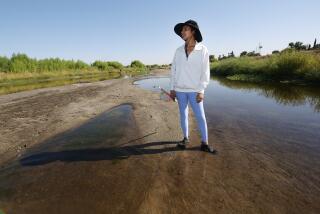State Tells U.S. It Has 3 Years to Clear Toxics in Bird Refuge
SACRAMENTO — The state Water Resources Control Board on Tuesday gave the federal government three years to clean up toxic contamination of the Kesterson National Wildlife Refuge, where birth defects in birds have been caused by farm runoff water.
By a unanimous vote, the board ordered the U.S. Bureau of Reclamation to either shut down Kesterson Reservoir or find a way to eliminate contamination caused by the element selenium and other toxics.
The contaminants, which occur naturally in soils in the western San Joaquin Valley where the reservoir is located, are carried to the Kesterson bird refuge by the San Luis Drain, an agricultural drainage system managed by the Bureau of Reclamation.
The accumulation of selenium has caused death and birth deformities in wildfowl that feed at Kesterson, which is part of the major migratory route known as the Pacific Flyway.
In addition, the board has determined that seepage of selenium from the marsh has polluted ground water in the area and that discharge of water from Kesterson could pollute the San Joaquin River.
Under the board’s order, it will be up to the Bureau of Reclamation to find a way to halt the contamination and clean up the 1,280-acre bird refuge. The bureau will have five months to prepare a detailed plan that meets with state approval and the rest of the three years to implement it.
The order is the state’s first attempt to force the federal government to take action at Kesterson, and Board Chairwoman Carole Onorato said, “It will accelerate the solution.”
Environmentalists and a Kesterson-area property owner criticized the board, however, for not requiring a more immediate halt to the flow of agricultural drain water into Kesterson.
“I want to see an order telling them: ‘Clean your sewage up or don’t dump it,’ ” said Jim Claus, who owns 650 acres of land used for duck hunting and cattle grazing. Claus prompted Tuesday’s action by filing a complaint with the water board.
And the San Francisco-based Natural Resources Defense Council said, “The serious hazards to public health and the environment caused by the ongoing dumping of toxic drain water cry out for immediate and decisive action.”
The fight over Kesterson could be just the beginning of a battle over about 500,000 acres of farm land in the western San Joaquin Valley.
Much of that land has recently been found to contain selenium and was scheduled for installation of an agricultural drain system similar to the one feeding water into Kesterson from about 8,000 acres of land.
In the past, the Bureau of Reclamation has disagreed with the state’s assessment of the severity of the pollution problem at Kesterson, state officials said.
Bureau attorney David Lindgren would not discuss the order Tuesday except to say: “Obviously we’re going to comply with the law. There are many options which include appeal, reconsideration and adhering to the order.
“Until we thoroughly have analyzed it, we simply aren’t going to be able to comment any further.”
Alternatives available to the bureau include such possibilities as constructing a treatment plant to remove the selenium and other toxics from the water, building a new set of holding ponds at another site where seepage would not be a problem and lining the Kesterson marshes with clay and plastic to prevent seepage into the underground water table.
The state board initially had considered giving the bureau three months to prepare its cleanup plan and two years to implement it. But Onorato said the board extended the time frame because of concern that the original deadlines were too tight.
“I have every reason now to believe they will cooperate with the order,” Onorato said.
Until the plan is prepared, she said, there is no way to estimate when the contamination of Kesterson will end.
In 1978, the Bureau of Reclamation began dumping water from subsurface agricultural drains into 12 shallow ponds known collectively as the Kesterson Reservoir.
The drainage system is designed to prevent salt from accumulating in the soil. Along with the salt, selenium and toxic heavy metals have been washed from the soil and dumped into Kesterson, where they have collected over the years.
The poisoning of the marsh became apparent in 1981 when most varieties of fish disappeared. In 1983, wildfowl were found to have such birth defects as missing eyes, missing parts of beaks and stubs instead of wings and legs. The cause was found to be selenium.
More to Read
Sign up for Essential California
The most important California stories and recommendations in your inbox every morning.
You may occasionally receive promotional content from the Los Angeles Times.










